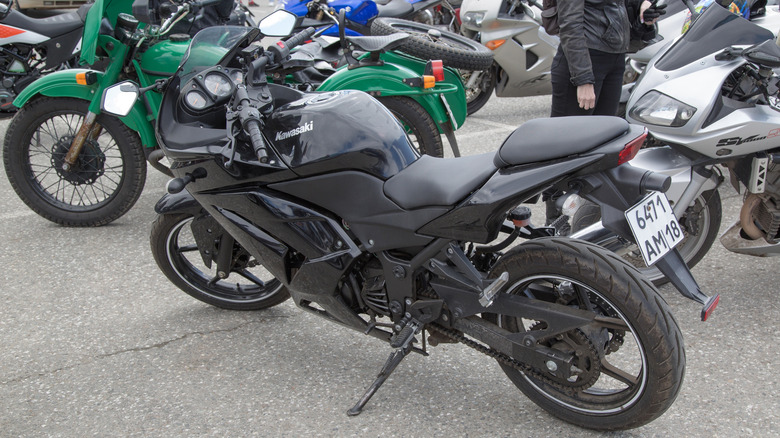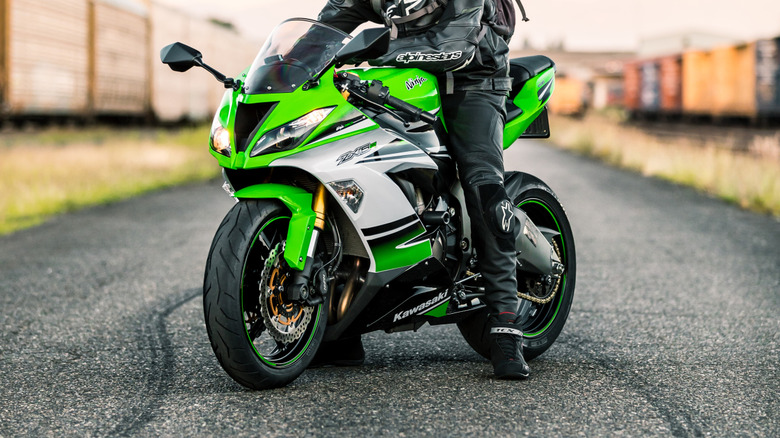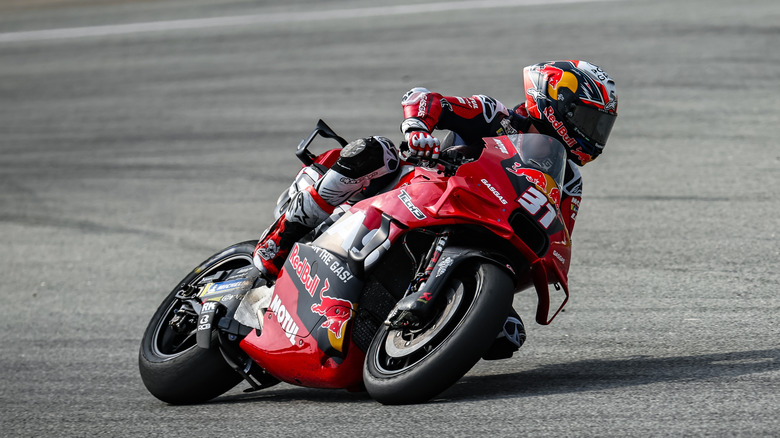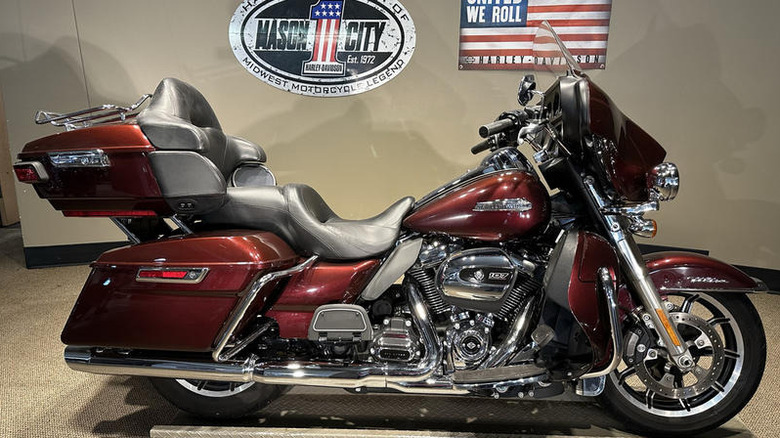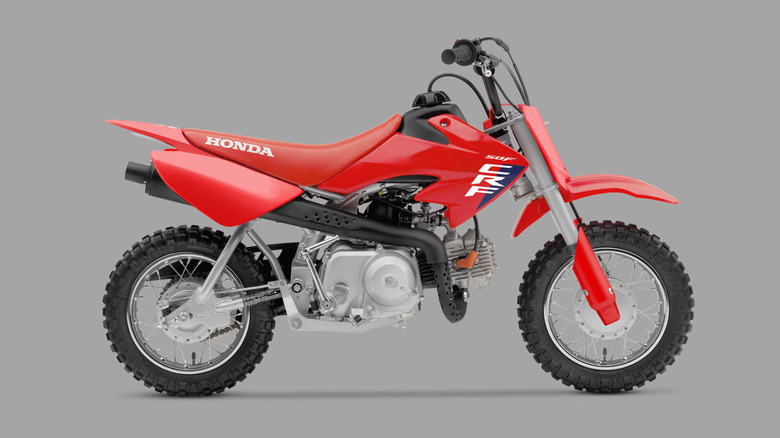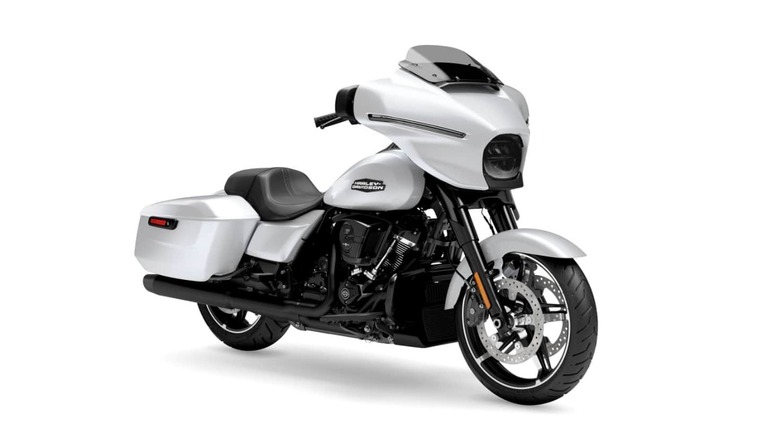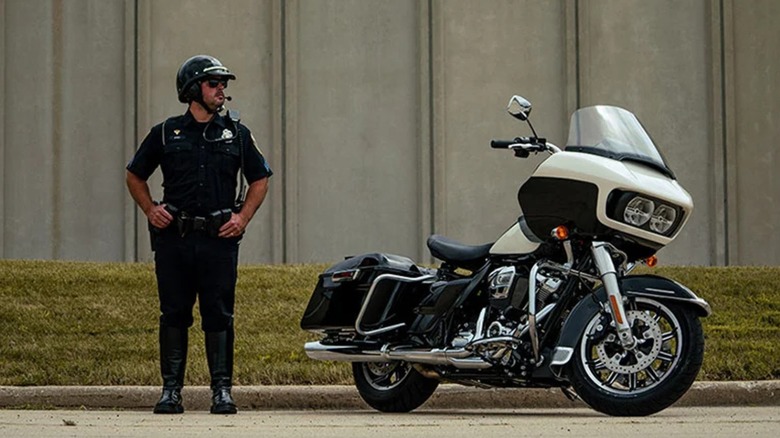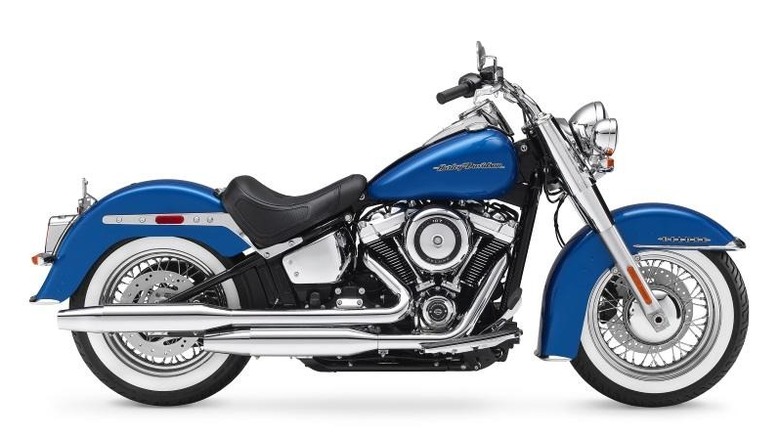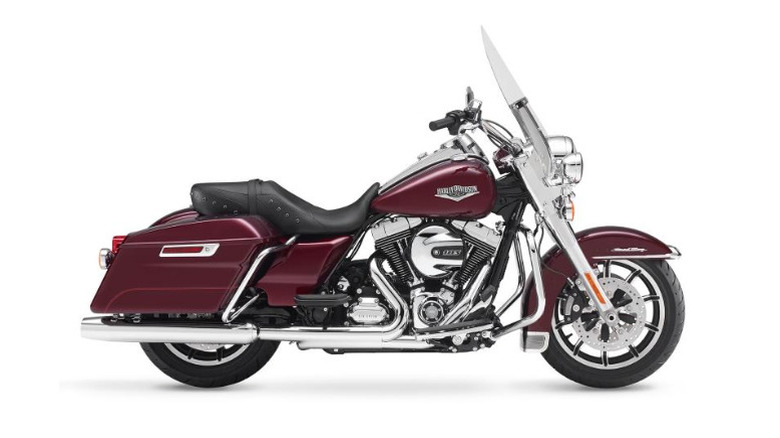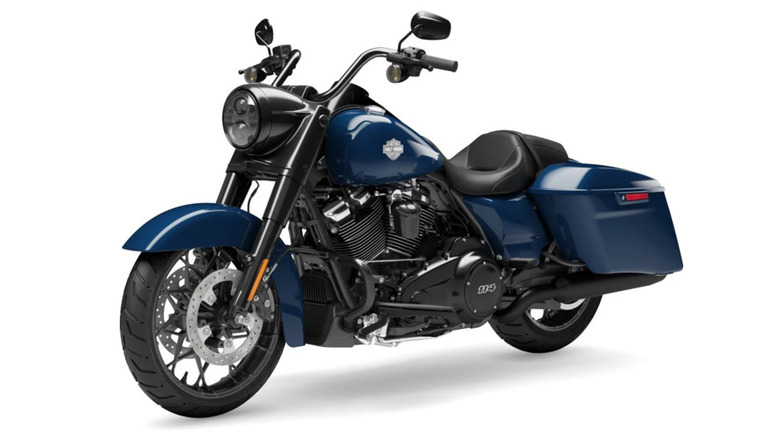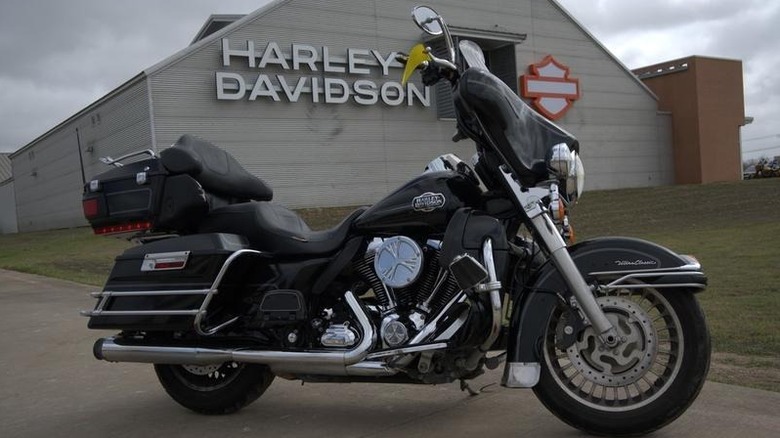13 Of The Biggest Motorcycle Recalls In Recent History
Recalls are never good news, but for motorcycle manufacturers, they're a reality in the industry. Sometimes they happen because of a single faulty part used across multiple models, while other times it's an isolated issue that still impacts thousands of riders. Either way, recalls highlight problems in design, production, or supply chains, and force companies to bring bikes back to dealerships for fixes.
Any brand in the market, regardless of its size or reputation, can face product recalls. Harley-Davidson has had multiple in recent years, including one that affected more than 250,000 motorcycles. Yamaha's throttle sensor failures triggered multiple product recalls that impacted thousands of units. Major brands of all kinds have run into instances when their products no longer meet their own safety or reliability standards, and in those cases many of have had to implement recalls. Looking at the biggest recalls of recent years reveals just how widespread the challenges can be across the motorcycle world.
August 2013 Kawasaki recall — 11,000+ motorcycles
The Ninja 300 is undoubtedly one of the most successful Kawasaki motorcycles of all time, but that does not mean its history is without blemishes. One such instance came in August 2013, when Kawasaki announced a recall for more than 11,000 Ninja 300 motorcycles in the U.S. after riders reported unexpected stalling during deceleration. The issue was traced to a faulty setting in the engine control unit (ECU), which caused the engine to shut off when the clutch lever was pulled to slow down or downshift.
The recall covered both standard and ABS versions of the Ninja 300 built between July 16, 2012, and April 27, 2013. Canada was also affected, with about 745 units included in the action. The U.S. recall followed months of owner complaints, some posted on online forums, and an investigation by the National Highway Traffic Safety Administration (NHTSA). One report described a serious crash where the rider was struck by another vehicle after the bike stalled, resulting in a fractured shoulder. In total, dozens of complaints were filed with NHTSA before Kawasaki took action.
Dealers resolved the defect by installing a new ECU at no cost to owners. Riders were strongly urged to schedule the fix quickly, as sudden stalling on busy roads or in corners presented a clear safety risk. This recall underscored the critical role of electronic systems in modern motorcycles, given a small programming error was the root of the problem.
June 2025 Kawasaki recall — 17,000+ motorcycles
In June 2025, Kawasaki issued a "do not ride" recall for more than 17,000 Ninja ZX-6R motorcycles from the 2024 and 2025 model years. The issue was traced to crankcase bolts that were over-tightened during assembly, damaging the No. 5 crankshaft bushing. This defect could cause the engine to seize unexpectedly, leading to a sudden loss of power and raising the risk of a crash.
The recall included multiple ZX-6R versions: the ABS model, ABS/KRT Edition, the 40th Anniversary Edition, and the standard ZX-6R/KRT trims, produced between April 2023 and April 28, 2025. While Kawasaki Europe noted that fewer than 1% of units showed the issue, U.S. regulators considered the safety risk serious enough to order an immediate stop-use notice. Owners were advised not to ride their motorcycles or even park them outdoors until repairs were completed.
The recall highlighted the potential danger of a small assembly error affecting a large production run. A seizing engine can instantly destabilize a motorcycle at high speeds, making it one of the most serious mechanical failures a rider can face.
May 2025 KTM recall — 20,000+ motorcycles
In May 2025, the KTM group (here's what KTM stands for, by the way) expanded a recall that ultimately affected more than 20,000 Husqvarna and GasGas off-road motorcycles in North America. The problem involved the front brake caliper, which could crack and reduce braking effectiveness, posing a crash hazard.
The recall covered roughly 19,310 bikes in the U.S. and another 3,870 in Canada. Models included Husqvarna's FE 350, FE 501, TE 150i, TE 250i, TE 300i, FX 350, and TX 300, as well as GasGas motorcycles like the EC 250, EC 300, EX 250, EX 300, EX 350F, and several MC motocross models — all built between 2022 and 2025. Owners could check if their motorcycle was part of the recall by looking at the tenth digit of the VIN: "N" for 2022, "P" for 2023, "R" for 2024, and "S" for 2025.
KTM advised riders to immediately stop using the affected motorcycles and contact an authorized Husqvarna or GasGas dealer for a free inspection and repair. If the caliper was found to be defective, dealers replaced it at no charge. KTM also reached out directly to owners and provided VIN lookup tools on Husqvarna and GasGas websites.
The timing of the recall was difficult for KTM, coming on the heels of a smaller, but still well known brake issue earlier in the yeary. For now, the defect appears limited to North America, with no equivalent recalls reported in Europe.
October 2013 Harley-Davidson recall — 29,000+ motorcycles
Back in October 2013, Harley-Davidson issued a recall for more than 29,000 motorcycles due to a defective clutch system that made it hard to release the clutch. This could make riders lose control of speed or breaking and lead to accidents.
The recall included 25,185 touring motorcycles and 3,861 Custom Vehicle Operations (CVO) and trike models built between May 3 and October 14, 2013. Harley recommended owners refrain from using their vehicles until all necessary repairs were done, and dealerships received guidance to stop delivering faulty products. Models covered included the FLHTCU, FLHTK, FLHTP, FLHX, FLHXS, FLHTKSE, and FLHRSE touring bikes, along with the FLHTCUTG, FXSBSE, and FLSTNSE from the CVO and trike lines.
Repairs were straightforward and typically took less than an hour to complete. Harley-Davidson reached out directly to affected owners and arranged free inspections and fixes. In some cases, dealerships even picked up motorcycles for service.
At the time, NHTSA was actually closed, due to a government shutdown, but Harley pushed ahead with the recall anyway, with general manager of Harley-Davidson Motorcycle New Product Delivery Tony Wilcox keeping the focus on rider safety in public statements. The swift action underscored the severity of the defect. A clutch that doesn't disengage can leave riders unable to control their motorcycle properly, making the voluntary recall necessary despite regulatory delays.
July 2024 Honda recall — 40,700 motorcycles
In July 2024, Honda recalled about 40,700 off-road motorcycles from the 2023 and 2024 model years due to a handlebar grip defect. The U.S. Consumer Product Safety Commission (CPSC) found that the grip could detach while in use, which would lead to dangerous accidents. Honda tied the defect to at least one incident that resulted in a knee injury.
The recall covered three small-displacement dirt bikes: the CRF125F, the CRF110F, and the CRF50F. The CRF125F was sold in red, while the CRF110F and CRF50F were available in both red and white. Riders could determine whether their motorcycle was included by checking the Vehicle Identification Number (VIN) on Honda's recall page.
Motorcycle owners who experienced problems were required to suspend their vehicle operation until after the necessary repairs. The solution required fixing or replacing the broken grip to stop it from coming loose. Dealers performed the work at no cost.
The CPSC recall notice demonstrated the actual danger level of this product defect. The separation of grip during mid-ride would produce unexpected instability because riders need to maintain their balance most when riding on unbalanced surfaces.
September 2024 Harley-Davidson recall — 41,000+ motorcycles
Harley-Davidson issued another significant recall in September 2024, this time affecting more than 41,000 motorcycles from the 2024 model year. The problem stemmed from an electrical defect that could lead to sudden power loss. According to filings with the NHTSA, the voltage regulator output wire could rub against the crankcase, which wore down the insulation and exposed the wire over time, creating the potential for a short circuit.
If the wire shorted, the fuse would blow and cut propulsion without warning. That also meant a complete loss of electrical power, making the situation even more dangerous. The recall applied to several 2024 models, including the Street Glide (FLHX), CVO Street Glide (FLHXSE), Road Glide (FLTRX), CVO Road Glide (FLTRXSE), and CVO Road Glide ST (FLTRXSTSE). Production dates ran from late October 2023 through mid-July 2024. Harley said a revised design introduced after that period resolved the issue.
Dealers were instructed to inspect the voltage regulator wire harness and install a retention strap to prevent future contact with the crankcase. If damage was discovered, the harness was replaced and fitted with an extension before the strap was added. Harley confirmed nine related field reports, but no accidents or injuries tied to the defect. Dealer notifications began in mid-September, followed by owner letters later that month. As with other recalls, the repairs were provided free of charge.
June 2017 Harley-Davidson recall — 46,000 motorcycles
In June 2017, Harley-Davidson recalled nearly 46,000 motorcycles in the U.S. after discovering that an oil cooler line clamp could be improperly installed during production. If the clamp detached, the oil line could come loose, causing a sudden loss of oil. In the worst cases, oil could spill directly onto the rear tire, dramatically increasing the chance of a crash.
The recall affected several 2017 models, including the Electra Glide Ultra Classic, Police Electra Glide, Police Road King, Road King, Road King Special, Street Glide, Street Glide Special, Road Glide, and Road Glide Special. Production dates ranged from July 2, 2016, to May 9, 2017.
Harley-Davidson first spotted the issue in March 2017 during testing. At first, the company believed the defect was isolated, but additional reports (including two crashes and one minor injury) forced a broader investigation. In total, nine field reports linked to oil line detachment were logged before Harley moved forward with the recall.
Dealers were instructed to inspect clamps identified by part numbers 10198, 10080, and 10344, and correct any improper installations. The repairs were simple and typically completed in less than an hour. As with other recalls, all work was provided free of charge.
June 2025 Harley-Davidson recall — 82,000 motorcycles
Harley-Davidson recalled more than 82,000 Softail motorcycles in June 2025 over a defect that could cause sudden loss of rear tire pressure. The problem was tied to a faulty rear shock pre-load adjuster mounting tab. The adjuster would risk hitting the rear tire if the tab broke because it would expose the sharp edge of the bolt, creating a risk of accidents.
The affected motorcycles were produced from 2018 to 2024. Specific models include the FLDE (2018–2019), FLHC (2018–2021), FLHCS (2018–2024), FLHCS ANV (2018, 2023), FXLRS (2020–2024), FXLRST (2022–2024), and FXRST (2022). The updated solution from Harley-Davidson targets motorcycles that underwent the previous 2023 recall work because the first remedy did not fully address the issue.
Dealers resolved the problem by installing a redesigned bracket that limited the adjuster's movement and kept it away from the tire. Repairs were carried out free of charge. Owners began receiving notification letters in mid-June 2025, but they could also verify their motorcycle's status through Harley-Davidson's online recall lookup tool using their VIN.
The company emphasized that other Softail models with different adjuster designs were not included. Harley-Davidson also reported no accidents or injuries related to the defect at the time of the recall. Still, the company urged owners of affected motorcycles to schedule service promptly to avoid potential safety risks.
July 2015 Harley-Davidson recall — 185,000+ motorcycles
In July 2015, Harley-Davidson announced a major recall covering more than 185,000 Touring motorcycles in the U.S. The issue was tied to saddlebags that could detach while riding, creating a road hazard and raising the risk of crashes. The problem came down to mounting hardware that failed to adequately secure the bags.
The recall spanned a wide range of Harley's most popular touring bikes, including the 2014–2015 Road King, Street Glide, Electra Glide Ultra Classic, Ultra Limited, Police Road King, and Police Electra Glide. Several CVO editions were also included, such as the CVO Ultra Limited and CVO Street Glide. Harley identified the defect through warranty claims pointing to weak saddlebag receptacles.
Owners were contacted beginning July 27, 2015, and asked to bring their motorcycles to an authorized dealership so they could be fitted with updated hardware designed to secure the bags properly. All work was performed at no cost to the customer.
While the recall covered a huge number of bikes, Harley-Davidson reported no crashes or injuries related to the issue at the time. Still, the scope of the action reflected how widespread the defect was. Touring models are built for long-distance riding, where secure storage is essential, making the recall particularly urgent for safety.
October 2022 Harley-Davidson recall — 200,000 motorcycles
In October 2022, Harley-Davidson recalled nearly 200,000 motorcycles and trikes in the U.S. due to a brake light issue caused by a software fault. The defect could cause the rear brake lights to remain illuminated even when riders weren't braking, leading other drivers to misjudge when a motorcycle was slowing down.
The recall included 31,572 Trike and CVO Trike models built between July 2018 and June 2022, as well as 167,847 Touring and CVO Touring motorcycles produced from July 2019 through June 2022. Models affected included the Road Glide, Street Glide, Electra Glide, Ultra Limited, Road King, and several CVO editions. According to Harley-Davidson, motorcycles built after June 24, 2022, had already received a new pressure switch and updated software during production, so they were not part of the recall.
Owners of affected Touring and CVO Touring bikes received a free software update from Harley-Davidson dealers. For Trike and CVO Trike models, dealers installed both updated software and a new pressure switch at no cost. Notifications were sent to dealers in late October, while owner letters went out between October 26 and November 2, 2022. Harley's internal investigation into unintended brake light illumination first began in 2021, but the company reopened it in 2022 after more data showed the problem persisted.
May 2021 Royal Enfield recall — 237,000 motorcycles
In May 2021, Royal Enfield announced a massive recall impacting nearly 237,000 motorcycles worldwide. The issue was traced to a defective ignition coil that could cause engine misfiring and, in rare cases, lead to an electrical short circuit.
The recall applied to the Meteor 350, Classic 350, and Bullet 350 models, all of which are some of the best motorcycles the company has put out. Affected motorcycles were built between December 2020 and April 2021, though the problem was limited to specific batches of materials sourced from an outside supplier during that period. Not every unit produced was affected, but Royal Enfield included a wide range of motorcycles as a precaution.
The recall covered bikes sold in India, Thailand, Indonesia, the Philippines, Australia, New Zealand, and Malaysia. According to the company, fewer than 10% of recalled units were expected to require actual replacement of the ignition coil. Repairs were carried out when necessary at no cost to owners.
Royal Enfield said the defect was discovered during routine internal testing. The proactive recall emphasized the company's focus on safety, particularly in the mid-size motorcycle market where it has a strong global presence.
October 2018 Harley-Davidson recall — 238,300 motorcycles
In October 2018, Harley-Davidson issued a worldwide recall affecting about 238,300 motorcycles. The problem involved a defect in the hydraulic clutch system that could prevent the clutch from disengaging, creating a serious safety risk. The recall included all 2017 and 2018 Touring, Trike, and CVO Touring models, along with some 2017 Softail motorcycles. Nearly 178,000 of the recalled units were in the U.S.
The defect concerned the hydraulic clutch system's secondary actuator. Fluid leaks could reduce pressure in the clutch master cylinder, making it difficult or impossible for the rider to disengage the clutch. This raised the risk of losing control when starting, shifting, or stopping.
Harley-Davidson first flagged the issue in January 2018 after a crash in Korea. By October, the company had collected 338 warranty claims and confirmed five crashes tied to the faulty component. Dealers addressed the issue by installing a redesigned secondary actuator piston assembly with an improved lip seal and surface finish. Repairs were provided free of charge, to the tune of around $35 million in total, though Harley sought reimbursement from the part's supplier.
This was not Harley-Davidson's first clutch-related recall. Similar problems had prompted recalls in 2013, 2015, and 2016, covering tens of thousands of motorcycles.
February 2018 Harley-Davidson recall — 250,000+ motorcycles
In early 2018, Harley-Davidson recalled more than 250,000 motorcycles worldwide due to a potential brake failure problem. The recall affected more than 30 models built between 2008 and 2011, including popular Touring, CVO Touring, and V-Rod bikes. About 175,000 of the recalled motorcycles were in the U.S.
The issue was linked to DOT 4 brake fluid when it wasn't replaced every two years, as specified in Harley's maintenance schedule. Over time, the fluid could absorb moisture and corrode the anti-lock braking system (ABS). This corrosion sometimes caused ABS valves to stick, leading to a sudden and total loss of braking power.
The NHTSA began investigating the issue in 2016 after receiving 43 complaints, including three crashes and two injuries. Harley initially suggested a service campaign reminding owners about maintenance, but regulators insisted on a full recall, which started on February 12, 2018. Owners were directed to authorized dealers for a complete brake fluid flush and replacement using Harley's Platinum Label DOT 4 fluid. The fix did not require hardware changes and was performed free of charge.
For riders, the defect was especially concerning because the failure could occur without warning. Unlike gradual brake fade, stuck ABS valves could leave a motorcycle with no braking ability at all. By covering a quarter-million units, Harley-Davidson's recall became one of the largest motorcycle safety actions in recent history.

